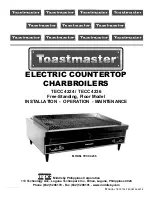
23
XIII. CHECKOUT PROCEDURE & ADJUSTMENTS
VERIFY PROPER SEQUENCE OF OPERATION
The sequence can be followed via the diagnostic indicator lamps on the Integrated Boiler Control in
Figure 16 (Section XI). This is the normal sequence of operation. A more detailed sequence of opera-
tion containing potential faults can be found in the service hints section.
NOTE:
The first one or two cold starts may be rough due to the gas line not being completely purged of air, causing low firing
rate and high excess air levels.
SEQUENCE OF OPERATION
DIAGNOSTIC
INDICATOR LAMPS
(1) Lamp A is illuminated, indicating that the integrated control is receiving
24 volts and is in standby waiting for the thermostat to call for heat.
(2) Thermostat calls for heat, energizing the system circulator.
(3) Integrated boiler control performs self check of internal circuitry,
lasting approximately two seconds, and energizes the draft inducer.
A.
B.
C.
D.
E.
(4) The draft inducer comes up to speed and establishes combustion
airflow, causing the normally open differential pressure air proving
switch contacts to close. When combustion airflow is proved, Lamp
B is illuminated indicating that the 15 second pre-purge cycle has
begun.
A.
B.
C.
D.
E.
(5) After the pre-purge has completed, Lamp B is extinguished and
Lamp C is illuminated, indicating power is being delivered to the hot
surface igniter for the 20 second igniter warm-up period. The bright
yellow-orange glow of the hot surface igniter can be observed through
the observation port on the boiler.
A.
B.
C.
D.
E.
(6) After the igniter warm-up period the integrated boiler control
energizes the gas valve, initiating a 6 second trial for ignition mode
which is indicated by the illumination of Lamp D. Two seconds later,
Lamp C will extinguish when the integrated boiler control stops
sending power to the hot surface igniter.
A.
B.
C.
D.
E.
(7) A low level illumination of Lamp E indicates the initiation of flame
proving. During the last 2 seconds of the trial for ignition mode, main
burner flame is proven by flame rectification through the hot surface
igniter, providing a flame signal that is relayed to the integrated boiler
control, fully illuminating Lamp E.
A.
B.
C.
D.
E.
(8) The thermostat ends its call for heat, causing the integrated boiler
control to de-energize the gas valve and system circulator. Lamp
D is extinguished while the unit enters the 30 second post purge
mode, indicated by the illumination of Lamp B. Lamp E will remain
illuminated as the remainder of the gas in the blower is burned off
(approximately 2 seconds). During post purge the blower remains
powered and clears out any residual products of combustion.
A.
B.
C.
D.
E.
(9) After the post purge mode the draft inducer is de-energized and
the unit goes into standby mode until the next call for heat from the
thermostat.
A.
B.
C.
D.
E.
















































